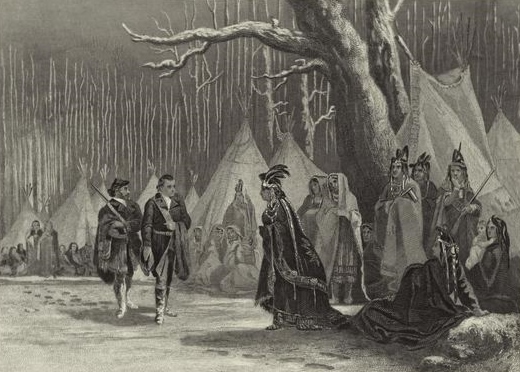 |
| Washington and Gist visit Queen Aliquippa. 1756 By Rogers, John, ca. 1808-ca. 1888 [Public domain], via Wikimedia Commons |
It wasn't until the summer months of 1748 when Queen Aliquippa was mentioned again. Conrad Weiser, who was in the region of Logstown was looking to enter tribes into a treaty with Pennsylvania. At the time, Queen Aliquippa was living in a village on the north bank of of the Allegheny River and a short distance from the Monongahela River.
She is mentioned in an August 27th, 1748 entry in Weiser's journal, as such: "Set off again in the morning early. Rainy weather. We dined at a Seneca town where an old Seneca woman [Queen Allaquippa] reigns with great authority. We dined at her house and they all used us very well."
Weiser left Queen Aliquippa
The entry in his entry was written: "The old Sinicker Queen from above, already mentioned, came to inform me some time ago that she had sent a string of wampum of three fathoms to Philadelphia by James Dunnings, to desire her brethren would send her up a cask of powder and some small shot to enable her to send out the Indian boys to kill turkeys and other fowls for her, whilst the men were gone to war against the French, that they may not be starved. I told her I had heard nothing of her message, but if she had told me of it before I had parted with all the powder and lead, I could have let her have some, and promised I would make inquiry; perhaps her messenger had lost it on the way to Philadelphia. I gave her a shirt, a Dutch wooden pipe and some tobacco. She seemed to have taken a little affront because I took not sufficient notice of her in coming down. I told her she acted very imprudently not to let me know by some of her friends who she was, as she knew very well I could not know by myself. She was satisfied, and went away with a deal of kind expressions."
By the Summer of 1749, Queen Aliquippa was seen by Pierre Joseph Céloron de Blainville near Shannopin's Town. Which was located on the east bank of the Allegheny River and also in the region of Pittsburgh. He wrote is his journal: "I re-embarked and visited the village which is called the Written Rock. The Iroquois inhabit this place, and it is an old woman of this nation who governs it. She regards herself as sovereign. She is entirely devoted to the English."
The Commissioners of Virginia, going by the names of Lomax, Fry, and Patten, arrived in the area of Logstown in 1752 and were looking to meet with Queen Aliquippa. She now was living on the south bank of the Ohio River and below the mouth of Chartiers Creek. They met on May 30, 1752 and she presented them with wampum and a 'fine dish of fish' and other provisions for their continuance on to Logstown. In return, they presented her with a brass kettle, tobacco, and other items and went on their way.
George Washington
After Washington's loss (as part of the British command leadership) against the French and their Native allies, he surrendered at Fort Necessity on July 4th, 1754. Meanwhile, Queen Aliquippa left the fort and moved on with her band and other tribes from the Fort Necessity region. They settled in Aughwick Valley in Huntingdon County, Pennsylvania. She was found dead on December 23, 1754 and it was thought she had passed prior to this date. George Croghan, in charge of Indian affairs at Aughwick, wrote to Colonial Authorities: ""Alequeapy, ye old quine (queen), is dead."
Her birth year is unknown, but it is estimated to be between the year 1670 and the early 1700s. Being that she and her husband may have visited William Penn in 1701, she was possibly born in the 1680s.

